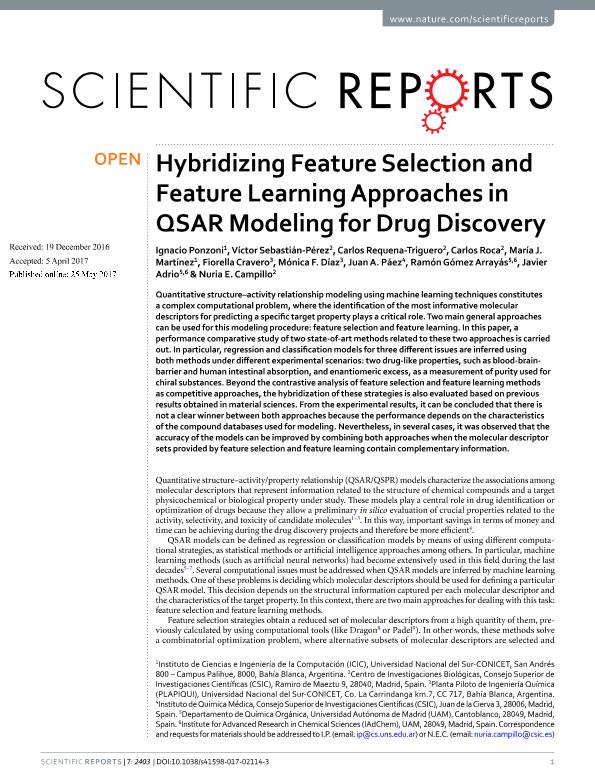Mostrar el registro sencillo del ítem
dc.contributor.author
Ponzoni, Ignacio

dc.contributor.author
Sebastián Pérez, Víctor
dc.contributor.author
Requena Triguero, Carlos
dc.contributor.author
Roca, Carlos
dc.contributor.author
Martínez, María Jimena

dc.contributor.author
Cravero, Fiorella

dc.contributor.author
Diaz, Monica Fatima

dc.contributor.author
Páez, Juan A.
dc.contributor.author
Gómez Arrayás, Ramón
dc.contributor.author
Adrio, Javier
dc.contributor.author
Campillo, Nuria E.
dc.date.available
2018-05-18T20:29:27Z
dc.date.issued
2017-05-25
dc.identifier.citation
Ponzoni, Ignacio; Sebastián Pérez, Víctor; Requena Triguero, Carlos; Roca, Carlos; Martínez, María Jimena; et al.; Hybridizing Feature Selection and Feature Learning Approaches in QSAR Modeling for Drug Discovery; Nature Publishing Group; Scientific Reports; 7; 1; 25-5-2017; 1-19
dc.identifier.issn
2045-2322
dc.identifier.uri
http://hdl.handle.net/11336/45651
dc.description.abstract
Quantitative structure–activity relationship modeling using machine learning techniques constitutes a complex computational problem, where the identification of the most informative molecular descriptors for predicting a specific target property plays a critical role. Two main general approaches can be used for this modeling procedure: feature selection and feature learning. In this paper, a performance comparative study of two state-of-art methods related to these two approaches is carried out. In particular, regression and classification models for three different issues are inferred using both methods under different experimental scenarios: two drug-like properties, such as blood-brain-barrier and human intestinal absorption, and enantiomeric excess, as a measurement of purity used for chiral substances. Beyond the contrastive analysis of feature selection and feature learning methods as competitive approaches, the hybridization of these strategies is also evaluated based on previous results obtained in material sciences. From the experimental results, it can be concluded that there is not a clear winner between both approaches because the performance depends on the characteristics of the compound databases used for modeling. Nevertheless, in several cases, it was observed that the accuracy of the models can be improved by combining both approaches when the molecular descriptor sets provided by feature selection and feature learning contain complementary information.
dc.format
application/pdf
dc.language.iso
eng
dc.publisher
Nature Publishing Group

dc.rights
info:eu-repo/semantics/openAccess
dc.rights.uri
https://creativecommons.org/licenses/by/2.5/ar/
dc.subject
Machine Learning
dc.subject
Qsar
dc.subject
Feature Selection
dc.subject
Feature Learning
dc.subject.classification
Ciencias de la Computación

dc.subject.classification
Ciencias de la Computación e Información

dc.subject.classification
CIENCIAS NATURALES Y EXACTAS

dc.title
Hybridizing Feature Selection and Feature Learning Approaches in QSAR Modeling for Drug Discovery
dc.type
info:eu-repo/semantics/article
dc.type
info:ar-repo/semantics/artículo
dc.type
info:eu-repo/semantics/publishedVersion
dc.date.updated
2018-04-18T17:42:48Z
dc.journal.volume
7
dc.journal.number
1
dc.journal.pagination
1-19
dc.journal.pais
Reino Unido

dc.journal.ciudad
Londres
dc.description.fil
Fil: Ponzoni, Ignacio. Consejo Nacional de Investigaciones Científicas y Técnicas. Centro Científico Tecnológico Conicet - Bahía Blanca. Instituto de Ciencias e Ingeniería de la Computación. Universidad Nacional del Sur. Departamento de Ciencias e Ingeniería de la Computación. Instituto de Ciencias e Ingeniería de la Computación; Argentina
dc.description.fil
Fil: Sebastián Pérez, Víctor. Consejo Superior de Investigaciones Científicas. Centro de Investigaciones Biológicas; España
dc.description.fil
Fil: Requena Triguero, Carlos. Consejo Superior de Investigaciones Científicas. Centro de Investigaciones Biológicas; España
dc.description.fil
Fil: Roca, Carlos. Consejo Superior de Investigaciones Científicas. Centro de Investigaciones Biológicas; España
dc.description.fil
Fil: Martínez, María Jimena. Consejo Nacional de Investigaciones Científicas y Técnicas. Centro Científico Tecnológico Conicet - Bahía Blanca. Instituto de Ciencias e Ingeniería de la Computación. Universidad Nacional del Sur. Departamento de Ciencias e Ingeniería de la Computación. Instituto de Ciencias e Ingeniería de la Computación; Argentina
dc.description.fil
Fil: Cravero, Fiorella. Consejo Nacional de Investigaciones Científicas y Técnicas. Centro Científico Tecnológico Conicet - Bahía Blanca. Planta Piloto de Ingeniería Química. Universidad Nacional del Sur. Planta Piloto de Ingeniería Química; Argentina
dc.description.fil
Fil: Diaz, Monica Fatima. Consejo Nacional de Investigaciones Científicas y Técnicas. Centro Científico Tecnológico Conicet - Bahía Blanca. Planta Piloto de Ingeniería Química. Universidad Nacional del Sur. Planta Piloto de Ingeniería Química; Argentina
dc.description.fil
Fil: Páez, Juan A.. Consejo Superior de Investigaciones Científicas. Instituto de Química Médica; España
dc.description.fil
Fil: Gómez Arrayás, Ramón. Universidad Autónoma de Madrid; España
dc.description.fil
Fil: Adrio, Javier. Universidad Autónoma de Madrid; España. Institute for Advanced Research in Chemical Sciences; España
dc.description.fil
Fil: Campillo, Nuria E.. Consejo Superior de Investigaciones Científicas. Centro de Investigaciones Biológicas; España
dc.journal.title
Scientific Reports
dc.relation.alternativeid
info:eu-repo/semantics/altIdentifier/url/https://www.nature.com/articles/s41598-017-02114-3
dc.relation.alternativeid
info:eu-repo/semantics/altIdentifier/doi/http://dx.doi.org/10.1038/s41598-017-02114-3
Archivos asociados
